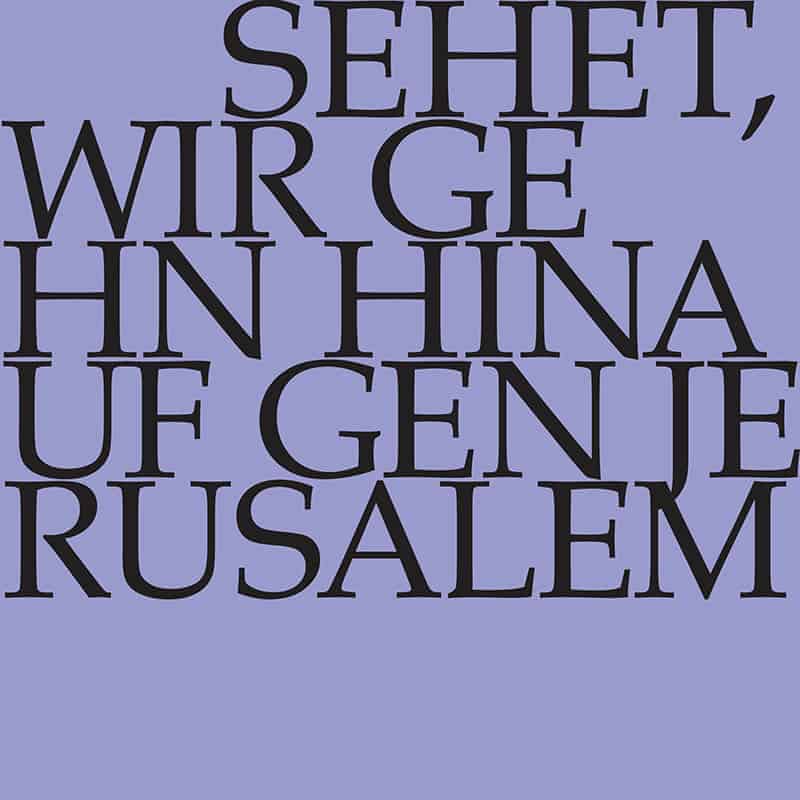Sehet, wir gehn hinauf gen Jerusalem
BWV 159 // For Estomihi
(See now, we’re going up to Jerusalem) for alto, tenor, bass and soprano section of the vocal ensemble, oboe, bassoon, strings and continuo
The cantata “Sehet, wir gehn hinauf gen Jerusalem” (See now, we’re going up to Jerusalem) BWV 159, was written for Estomihi, the last Sunday service with concerted music prior to the musical dearth of Passiontide. Composed to a libretto by Picander that was published in 1728, the cantata anticipates the impending crucifixion of Jesus, while also reflecting on the consequences it bears for the faithful individual and the disciples.

Would you like to enjoy our videos ad-free? Subscribe to YouTube Premium now...
Workshop
Reflective lecture
Choir
Soprano
Mirjam Berli, Susanne Frei, Guro Hjemli, Damaris Nussbaumer
Orchestra
Conductor
Rudolf Lutz
Violin
Renate Steinmann, Dorothee Mühleisen
Viola
Susanna Hefti
Violoncello
Claire Pottinger
Violone
Iris Finkbeiner
Oboe
Katharina Arfken
Bassoon
Xavier Alig
Organ
Norbert Zeilberger
Musical director & conductor
Rudolf Lutz
Workshop
Participants
Karl Graf, Rudolf Lutz
Reflective lecture
Speaker
Niklaus Peter
Recording & editing
Recording date
02/17/2012
Recording location
Trogen
Sound engineer
Stefan Ritzenthaler
Director
Meinrad Keel
Production manager
Johannes Widmer
Production
GALLUS MEDIA AG, Switzerland
Producer
J.S. Bach Foundation of St. Gallen, Switzerland
Librettist
Text
Christian Friedrich Henrici,
known as Picander (1700—1764)
First performance
Estomihi,
27 February 1729
In-depth analysis
Right from the introductory movement featuring Jesus (bass) and the soul (alto), this interplay between the gospel story and commentary is mirrored in the musical structure, with the arioso words of Christ alternating with the string-accompanied recitative. Through an ascending, yet faltering continuo line that culminates in a dissonant leap, Bach evokes the apprehension in the face of the “cruel path” ahead, while the warning interjections from the distressed soul are emphatically commiserative. Nevertheless, Jesus continues undeterred on his predestined path with his grand, “See now!” gesture arching high over the pauses in the bass continuo, which serve as a symbol of mortal weakness. Moreover, Jesus’ vocal lines do not falter, but ascend undaunted up to E-flat’.
The following movement is also set as a disparate duet. In a theatrical baroque gesture, the alto declares an unswerving desire to follow Jesus “through spitting and scorn” – in other words through persecution and degradation – with the voice and continuo imitating one another along running figures. The entry of the soprano part adds a further layer with a verse alluding to the Passion “I will here by thee tarry, do not treat me with scorn!”, thus turning the duet into a chorale trio with two obbligato lower voices. The notion that the crucified Jesus can find his tomb in the heart of every believer, or that the restorative described in the tenor recitative is to be found in one’s own tears, may sound somewhat foreign today. However, it transforms the pronouncement of the bass aria “It is complete” – the penultimate words of Christ on the cross – into an experience that can be related to human lives. With its fragile oboe cantilena and freely flowing orchestral accompaniment, this expansive aria is one of Bach’s most moving compositions. The sighing of the vocal part no longer embodies burden and sorrow, but fulfilment and peace at the end of life’s path: “The pain is over” and the chasm of “sinful ruin” has been overcome. The redeeming sacrifice of Jesus and a joyous, but in no way naive renunciation of the world converge to create a peerless movement that seems as unending as twilight on the final day of creation. The closing Chorale “Jesu, this thy passion is my purest pleasure” brings this longing, but weary mood in tenderly rendered antithetical turns to its final expression: from the harsh C minor of the cantata’s beginning, the work has progressed to conclude in an E-flat major of inner radiance.
Libretto
1. Arioso (Bass) und Rezitativ (Alt)
Sehet!
Komm, schaue doch, mein Sinn,
wo geht dein Jesus hin?
wir gehn hinauf
O harter Gang! hinauf?
O ungeheurer Berg, den meine Sünden zeigen!
Wie sauer wirst du müssen steigen!
Gen Jerusalem.
Ach, gehe nicht!
Dein Kreuz ist dir schon zugericht’,
wo du dich sollt zu Tode bluten,
hier sucht man Geißeln für, dort bind man Ruten;
die Bande warten dein,
ach! gehe selber nicht hinein!
Doch, bliebest du zurükke stehen,
so müsst ich selbst nicht nach Jerusalem,
ach! leider in die Hölle gehen.
2. Arie (Alt) und Choral (Sopran)
Ich folge dir nach
Ich will hier bei dir stehen,
verachte mich doch nicht!
durch Speichel und Schmach;
Von dir will ich nicht gehen,
am Kreuz will ich dich noch umfangen,
bis dir dein Herze bricht.
dich lass ich nicht aus meiner Brust,
Wenn dein Haupt wird erblassen
im letzten Todesstoss,
und wenn du endlich scheiden musst,
alsdenn will ich dich fassen,
sollst du dein Grab in mir erlangen.
in meinen Arm und Schoss.
3. Rezitativ (Tenor)
Nun will ich mich,
mein Jesu, über dich
in meinem Winkel grämen.
Die Welt mag immerhin
den Gift der Wollust zu sich nehmen,
ich labe mich an meinen Tränen
und will mich eher nicht
nach einer Freude sehnen,
bis dich mein Angesicht
wird in der Herrlichkeit erblikken,
bis ich durch dich erlöset bin;
da will ich mich mit dir erquikken.
4. Arie (Bass)
Es ist vollbracht,
das Leid ist alle,
wir sind von unserm Sündenfalle
in Gott gerecht gemacht.
Nun will ich eilen
und meinem Jesu Dank erteilen,
Welt, gute Nacht,
es ist vollbracht!
5. Choral
Jesu, deine Passion
ist mir lauter Freude,
deine Wunden, Kron und Hohn
meines Herzens Weide.
Meine Seel auf Rosen geht,
wenn ich dran gedenke;
in dem Himmel eine Stätt
mir deswegen schenke.



